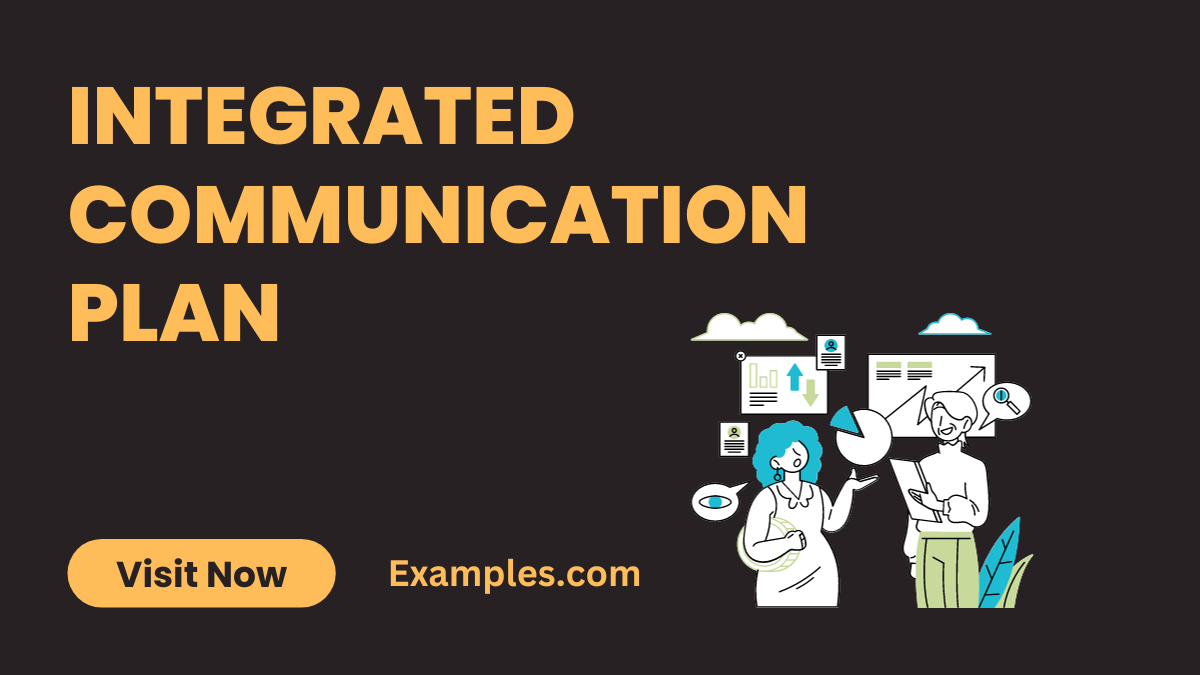6+ Integrated Communication Plan Examples
Discover the essence of an Integrated Communication Plan with our comprehensive guide, brimming with practical Communication Examples. This resource is tailored to provide you with a deep understanding of how to effectively synchronize various communication channels for maximum impact. From real-world examples to innovative strategies, this guide is an essential toolkit for anyone looking to enhance their communication skills in a dynamic and interconnected environment. Embrace the power of cohesive messaging and transform your communication approach today.
Download Integrated Communication Plan Bundle
Integrated Communication Plan

The comprehensive overview of creating an Integrated Communication Plan (ICP). It covers key aspects like unified messaging, audience engagement, brand consistency, and measurable outcomes. The plan targets both primary (corporate clients, business partners) and secondary audiences (public, media) using a mix of digital and traditional channels. It includes a strategic implementation plan with budget allocation and risk management, emphasizing regular assessment and flexibility for market adaptability
Integrated Marketing Communications Plan
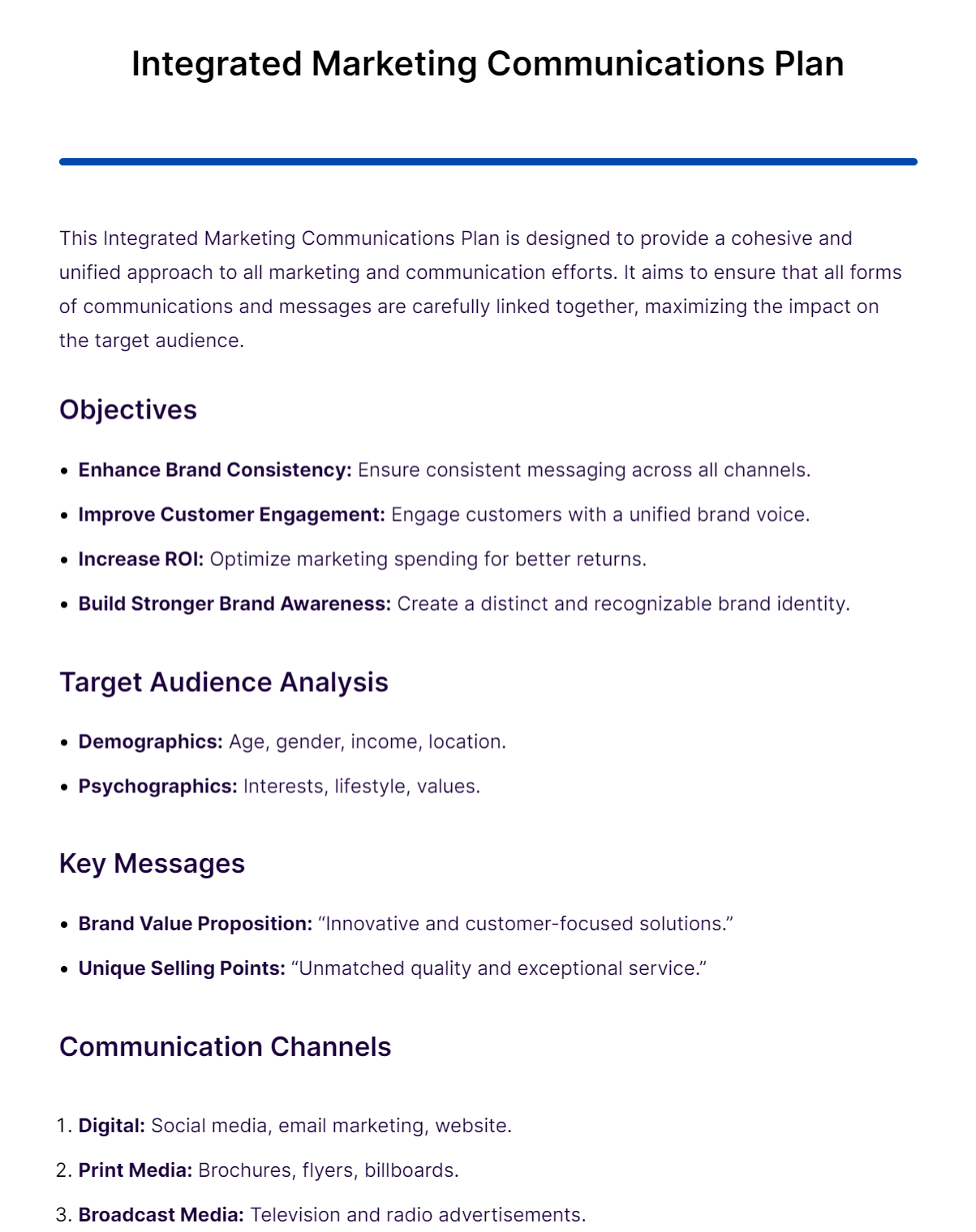
The Integrated Marketing Communications Plans. It covers various aspects such as brand consistency, customer engagement, return on investment, and brand awareness. The plan includes audience analysis, key messaging, multiple communication channels, and a detailed content strategy. It also outlines an implementation timeline, budget allocation, and methods for monitoring and evaluation, including risk management strategies. This resource is valuable for those looking to create an effective IMC plan
Integrated Marketing Communications Plan for New Product Launch
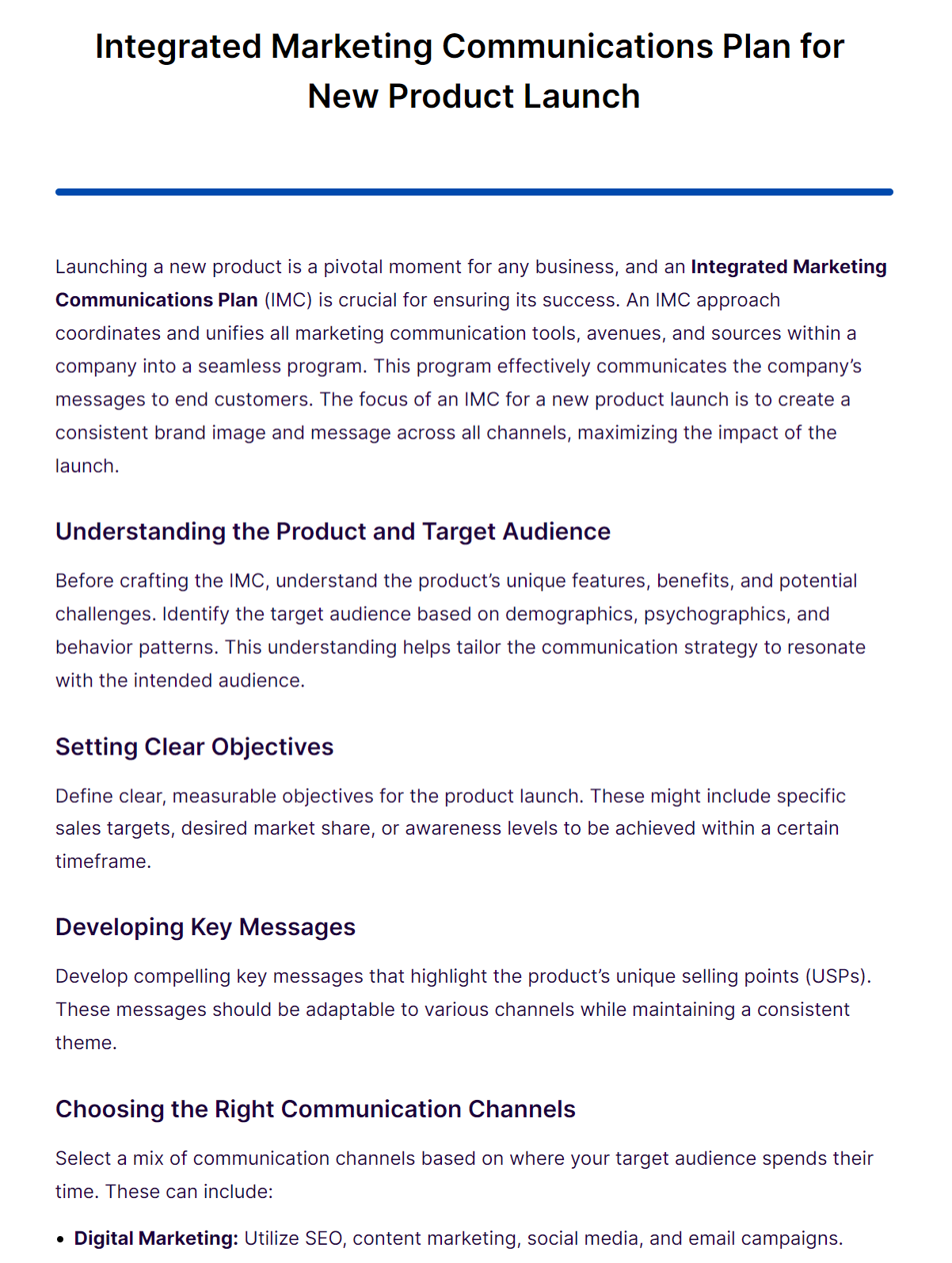
The Integrated Marketing Communications (IMC) plan for new product launches. It covers essential aspects like understanding the product and target audience, setting measurable objectives, developing key messages, selecting communication channels, and crafting an integrated content strategy. Additionally, it emphasizes budget allocation, implementation, monitoring, evaluation, and the need for flexibility in strategy adjustments
Integrated Marketing Communications Plan Template
Integrated Marketing Communication Advertising Plan Template
Integrated Marketing Communications Strategy Example
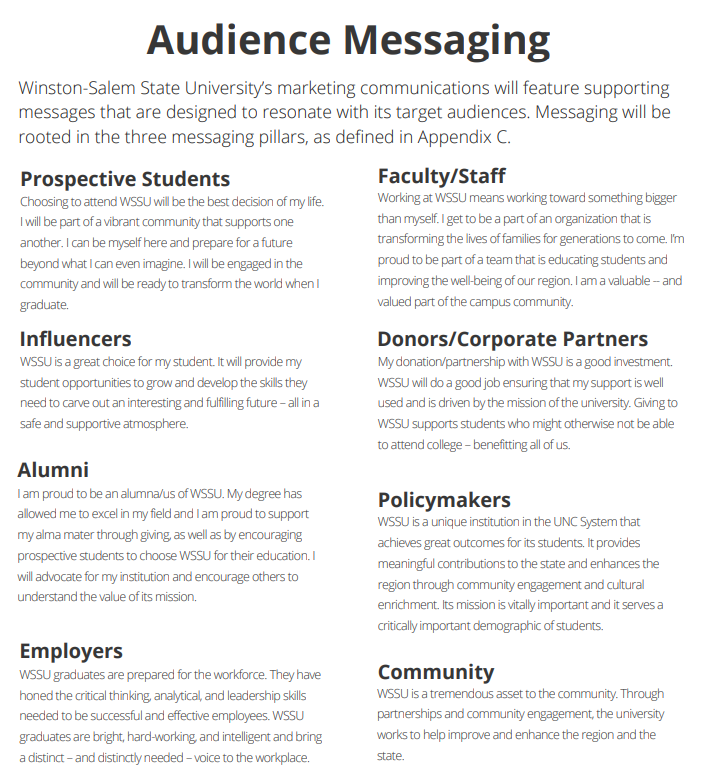
wssu.edu
DownloadFundamentals of Integrated Marketing Communications
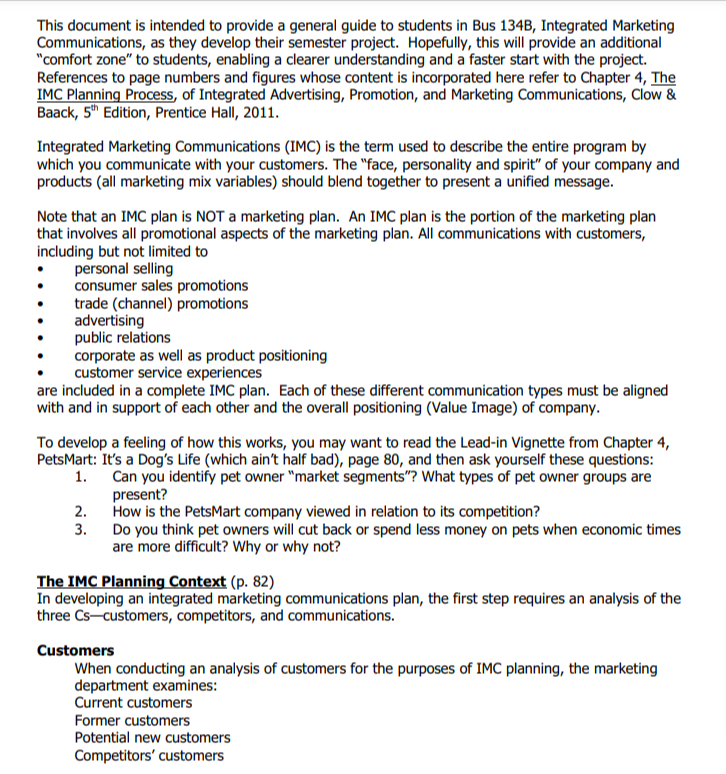
sjsu.edu
DownloadSteps to Create an Integrated Marketing Communications Strategy
Creating an Integrated Marketing Communications Strategy involves a series of steps that ensure all marketing efforts are unified and effective. This strategy aligns various communication channels and messages, enhancing brand consistency and customer engagement.
- Define Clear Objectives:
- Explanation: Start by setting specific, measurable goals that align with your business objectives. This step provides direction and purpose for your communications strategy.
- Example: “Our objective is to increase online engagement by 30% over the next quarter.”
- Understand Your Target Audience:
- Explanation: Identifying and understanding your target audience is crucial for effective messaging. This involves researching their needs, preferences, and behavior.
- Example: “Our primary audience is tech-savvy millennials who prioritize sustainability in their purchases.”
- Develop a Consistent Brand Message:
- Explanation: Craft a unified brand message that conveys your brand’s values and unique selling proposition across all channels.
- Example: “We provide innovative solutions with a commitment to environmental responsibility.”
- Choose the Right Communication Channels:
- Explanation: Select channels that best reach your target audience, considering both digital and traditional media.
- Example: “We will focus on social media and influencer partnerships to reach our audience effectively.”
- Create Engaging Content:
- Explanation: Develop content that resonates with your audience, is relevant, and aligns with your brand message.
- Example: “Our content will include interactive tutorials and customer stories highlighting our product’s impact.”
- Integrate Multi-Channel Strategies:
- Explanation: Ensure that your strategy effectively integrates various channels for a cohesive customer experience.
- Example: “Our email campaigns will complement our social media efforts, providing a seamless customer journey.”
- Budget Allocation and Management:
- Explanation: Allocate your budget effectively across different channels, ensuring optimal use of resources for maximum impact.
- Example: “40% of our budget will be dedicated to digital marketing, with a focus on SEO and content creation.”
- Monitor and Measure Performance:
- Explanation: Use analytics to track the performance of your campaigns, enabling data-driven decisions for improvements.
- Example: “We will monitor engagement metrics weekly to gauge the success of our social media campaigns.”
- Adapt and Optimize:
- Explanation: Continuously adapt your strategy based on performance data and changing market trends.
- Example: “Based on monthly analytics, we will refine our messaging to better resonate with our audience.”
- Encourage Team Collaboration:
- Explanation: Foster a collaborative environment where team members from different departments contribute to the communication strategy.
- Example: “Our marketing and sales teams will work together monthly to align messaging and tactics.
How to Develop an Integrated Marketing Communications Plan?
Developing an Integrated Marketing Communications Plan is a strategic approach that harmonizes all aspects of marketing communication, such as advertising, sales promotion, public relations, and direct marketing, to provide clarity, consistency, and maximum communication impact. Here’s a comprehensive guide to develop an effective plan:
1. Understand Your Target Audience
- Research: Conduct thorough market research to understand your audience’s demographics, psychographics, and buying behaviors.
- Segmentation: Divide your audience into distinct segments based on their characteristics and preferences.
- Insights: Gather insights on what motivates your audience, their pain points, and the channels they frequent.
2. Define Clear Objectives
- Specific Goals: Set specific, measurable, achievable, relevant, and time-bound (SMART) goals for your communication plan.
- Alignment with Business Goals: Ensure that your marketing communication objectives align with the overall business goals.
3. Craft Your Key Messages
- Consistency: Develop clear and consistent messages that resonate with your target audience and reflect your brand’s values and unique selling propositions.
- Adaptability: Tailor your messages for different audience segments and communication channels.
4. Choose the Right Communication Channels
- Multichannel Approach: Select a mix of traditional and digital channels based on where your audience is most active.
- Integration: Ensure that all channels work together seamlessly, reinforcing the same message in different ways.
5. Develop a Content Strategy
- Content Types: Plan a variety of content types like blogs, social media posts, email newsletters, and press releases.
- Editorial Calendar: Create an editorial calendar to schedule and manage content across different channels.
6. Allocate Budget
- Budget Planning: Allocate your budget based on the channels and activities that will give you the best ROI.
- Cost-Efficiency: Look for cost-effective solutions without compromising on the quality and impact of your communications.
7. Implement the Plan
- Team Involvement: Involve your marketing, sales, and communication teams in the implementation process.
- Consistency: Ensure that all communications are consistent with your brand voice and key messages.
8. Monitor and Evaluate
- KPIs and Metrics: Define key performance indicators (KPIs) and metrics to measure the effectiveness of your communications.
- Feedback Loops: Incorporate feedback mechanisms to gather insights from your audience and make necessary adjustments.
9. Adjust and Optimize
- Continuous Improvement: Regularly review the performance of your communication efforts and make adjustments as needed.
- Stay Current: Keep up with the latest trends in marketing communications and incorporate new ideas and technologies where appropriate
What is the Goal of Integrated Communication Plan ?
An Integrated Communication Plan is a strategic approach that combines all marketing, advertising, and communication efforts under a single unified strategy. The primary goal of this plan is to ensure consistency and harmony in messaging across all channels, ultimately enhancing the effectiveness of communication with the target audience. This approach leads to a more coherent brand identity, making the messaging more impactful and memorable.
Key Goals of an Integrated Communication Plan
- Consistency in Messaging: By integrating communication efforts, the plan ensures that all messages, regardless of the channel, consistently reflect the brand’s values and objectives. This consistency reinforces the brand image, making it more recognizable and reliable in the eyes of the consumers.
- Maximized Reach and Impact: The plan aims to leverage multiple channels — digital, print, broadcast, and more — to reach a wider audience. By doing so, it ensures that the messaging resonates with a diverse audience, maximizing the overall impact of the marketing efforts.
- Cost-Effectiveness: An Integrated Communication Plan optimizes the budget by eliminating redundant efforts across different channels. By coordinating and streamlining marketing activities, it ensures a more efficient use of resources, leading to a better return on investment.
- Enhanced Customer Engagement: Through a unified communication strategy, the plan fosters deeper engagement with the audience. It creates a consistent and compelling narrative that resonates with customers, encouraging interaction and loyalty.
- Data-Driven Decision Making: This approach allows for better tracking and analysis of marketing efforts across various channels. By evaluating the effectiveness of different strategies, businesses can make data-driven decisions, further refining their marketing and communication tactics.
- Adaptability to Market Changes: The plan is designed to be flexible, enabling businesses to quickly adapt to market changes or new trends. This agility ensures that the communication remains relevant and effective, even in a dynamic market environment.
- Building Long-term Relationships: By delivering consistent and relevant messages, an integrated plan aims to build and maintain long-term relationships with customers, establishing trust and loyalty.
- Alignment with Business Objectives: Finally, the plan aligns all communication efforts with the overarching business goals. Whether it’s increasing sales, improving brand awareness, or entering new markets, the integrated approach ensures that every communication effort contributes towards these objectives.
The importance and benefits of an Integrated Marketing Communications (IMC) plan. An IMC plan combines different marketing components to efficiently meet customer needs, involving market research, strategic planning, audience segmentation, and various communication channels. This approach ensures consistent messaging across different media, enhancing customer relationships, increasing sales, and building brand loyalty. The university offers an online Master’s program focusing on IMC, teaching students to develop comprehensive IMC plans incorporating various strategies and analysis tools.
The article from the steps to develop an Integrated Marketing Communications (IMC) plan. It emphasizes understanding the target audience, setting clear objectives, crafting a strategic campaign, measuring success through key performance indicators, and continuously refining the strategy. The article also highlights the importance of integrating messages across multiple channels, tailoring content for each channel, and staying updated with market trends and customer characteristics.



